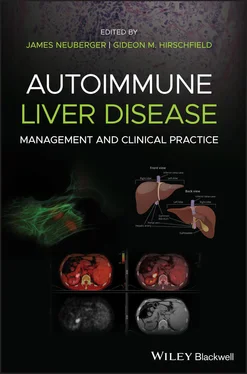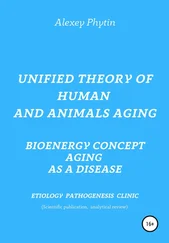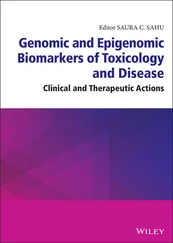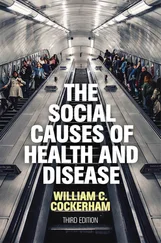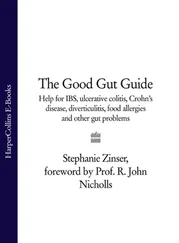Hepatic Kupffer cells regulate T‐cell homeostasis by inducing apoptosis of senescent T cells expressing CD95 (Fas), TNF‐apoptosis‐inducing ligand (TRAIL), and programmed cell death 1 (PD‐1) receptors. Furthermore, binding of Kupffer cell PD‐L1 to PD‐1 expressed by activated CD4 T cells induces immunosuppressive IL‐10 and reduces apoptosis of CD4 T regulatory cells (Tregs).
Mucosal invariant T (MAIT) cells have characteristics of both innate and adaptive immune cells that are relevant in AILDs [7]. MAIT cells have invariant TCR α‐chains that respond to bacterially processed vitamin B antigens presented by unique major histocompatibility complex (MHC) class I‐related molecules (MR‐1) on APCs. Normally found only in blood, gut mucosa and mesenteric lymph nodes, MAIT cells congregate in the portal tracts of patients with chronic liver diseases, including AIH, PBC, PSC, alcoholic and non‐alcoholic fatty liver diseases, and chronic hepatitis C virus (HCV) infection. Proinflammatory cytokines IL‐12 and IL‐18 activate MAIT cells to display dual characteristics of CD4 Th1 and Th17 cells by secreting interferon (IFN)‐γ, TNF‐α and IL‐17. Up to 25% express cytotoxic granzyme B, a feature of cytotoxic NK, NKT, and CD8 T cells. Importantly, MAIT cell cytokines stimulate cholangiocyte secretion of cytokines capable of transforming CD4 iTregs into proinflammatory CD4 Th17 cells ( Figure 2.2).
Generation and Maintenance of Tolerance to Self‐antigens
Overview
Immune tolerance is the ability of the immune system to identify and respond to foreign or non‐self‐antigens, while aborting or controlling potentially deleterious responses to autoantigens [1]. Despite genetic variability within the population and substantial differences in environmental exposures that shape an individual's immune repertoire, the vast majority of people maintain immune tolerance to self‐antigens. As a result, autoimmune diseases are rare, even among persons with genetic susceptibility [2]. In contrast, rare monogenetic defects predictably result in the development of autoimmune diseases in early life [1]. Broadly, immune tolerance is divided into two categories: natural and inducible tolerance. In addition, natural tolerance has been subclassified as either central or peripheral, based the anatomic site of development.
Central tolerance involves clonal deletion, clonal anergy or receptor editing to eliminate autoreactive αβT cells in the thymus [8] and autoreactive B cells in the bone marrow [9]. The tolerogenic mechanisms for different immune cell lineages show similarities and differences.
T cells with high affinity TCRs for self HLA–self peptide complexes are eliminated in the thymus by clonal deletion [8]. This process of negative selection favors the survival of T cells with TCRs that exhibit either no or very low affinity for self‐HLA–autoantigen peptide complexes. Among the natural (n) αβT cells selected in the thymus are subsets of CD4 T cells, including nTregs, NKT cells, and IL‐17‐secreting nTh17 cells. Given the dichotomous functions of nTregs and nTh17 cells to suppress versus augment inflammatory pathology, thymic regulation of the balance of these subsets is an important determinant of the risk for autoimmunity. Overall, more than 95% of T cells generated in the thymus undergo deletion because of excessive self‐reactivity, which underscores the high frequency of autoreactive TCRs among T cells.
Negative selection of autoreactive T cells by is mediated by the coordinated display of self‐HLA molecules containing self‐peptides generated by expression of genes controlled by the autoimmune regulator (AIRE) transcription factor. In addition to DCs, medullary thymic epithelial cells (mTECs) selectively express AIRE, which drives tissue‐specific self‐antigen expression required for deletion of T cells with TCRs that react strongly with autoantigens. In addition, thymic B class switching also promotes central tolerance through negative selection of CD4 T cells. The importance of AIRE in central tolerance is underscored by the consequences of genetic AIRE deficiency in humans, which results in an autoimmune disease characterized by autoimmune polyendocrine syndrome type 1 (APS‐1) [1]. AIRE is also involved in peripheral T‐cell tolerance and is expressed in peripheral lymph nodes and the spleen where it mediates elimination of autoreactive extrathymic T cells.
Thymic editing of TCRs plays a seminal role in the genesis of the TCR repertoire and is mediated by recombination activating gene (RAG)‐1 and RAG‐2 proteins. After RAG proteins are induced during T‐cell development, they cause TCR β‐chain rearrangement and expression of prefabricated TCR α‐chains to form pre‐TCRs. A subsequent round of RAG protein induction transcribes rearranged TCR α‐chains that displace prefabricated α‐chains. Yet another round of induction of RAG proteins finalizes rearrangements of α‐chains, forming functional α/β TCRs to undergo thymic selection. This thymic process of TCR editing has a counterpart in the periphery, referred to as TCR revision, which can generate an unlimited array of antigen‐specific TCRs, overcoming the effects of thymic TCR selection. These newly generated TCRs likely contribute to peripheral creation and evolution of autoreactive T cells (discussed later).
B cells develop tolerance to self‐antigens in the bone marrow by both B‐cell receptor (BCR) editing and clonal deletion of autoreactive B cells [9]. BCR editing results from the induction of VDJ recombinase and rearrangements which lead to production of new immunoglobulin‐edited light chains that modify the specificity of BCRs to prevent recognition of autoantigens.
Central immunologic tolerance for both T and B cells occurs in the early developmental stages of both lineages. Additional mechanisms are required, however, to achieve tolerance to self‐antigens that are not expressed during fetal or neonatal life or are expressed exclusively in peripheral non‐lymphoid organs [10].
T‐ and B‐cell Clonal Anergy
Clonal anergy is a major mechanism in the generation and maintenance of peripheral tolerance to self‐antigens ( Figure 2.2) [10]. Autoreactive T‐cell clones not deleted in the thymus or the peripheral lymphoid tissues may become anergic to autoantigens if TCR activation occurs in the absence of obligatory costimulation. Lack of costimulation results in inadequate secretion of IL‐2 and growth factors required for T‐cell clonal proliferation and maturation of effector functions. Without costimulation, autoantigen‐specific T cells cease to differentiate and fail to respond if reexposed to autoantigen. Anergic B cells have reduced surface IgM, impaired signal transduction and short lifespans, and exhibit anergy to autoantigen reexposure.
T‐cell Mediated Immune Regulation
A subclass of CD4 T cells referred to as Tregs are essential for peripheral tolerance and maintenance of immune homeostasis ( Figure 2.2) [11]. Tregs mediate immune tolerance by functionally suppressing all activated CD4 T‐cell subsets and CD8 CTLs. Thus, reductions in the numbers or functional capacity of Tregs can facilitate autoimmunity and autoimmune diseases. Phenotypically, Tregs are CD4, CD25, forkhead box P3 (FoxP3) T cells. FoxP3 is the key regulator of Treg function, as shown by monogenic deficiency in FOXP3 that results in immunodysregulation, polyendocrinopathy and enteropathy X‐linked (IPEX) syndrome [1]. FoxP3‐deficient mice also develop autoimmune diseases, which can be prevented by adoptive transfer of CD4, CD25, FoxP3 Tregs. FoxP3 Tregs secrete immunoregulatory and immunosuppressive cytokines, including, IL‐9, IL‐35, IL‐10 and transforming growth factor (TGF)‐β. These cytokines immunosuppress activated CD4 and CD8 T cells and promote T‐cell anergy by downregulating APC expression of costimulatory CD80 and CD86. In addition, Treg upregulation of intracellular cyclic AMP directly inhibits cell proliferation and reduces production of IL‐2 required for T‐cell proliferation.
Читать дальше
